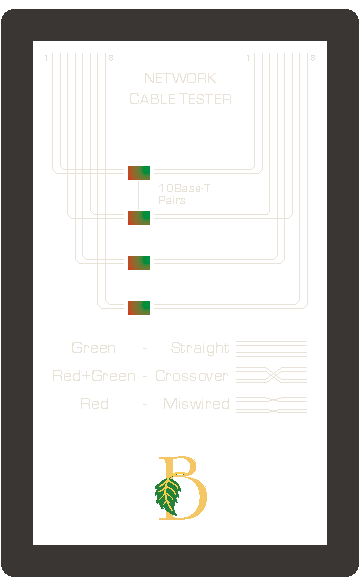Network Cable Tester
Model MCT-NET
The MCT-NET is an economical, one-step continuity tester to quickly verify the integrity of computer network cables.
 Instantly verify computer network cables
conforming to the EIA/TIA 568A/568B and AT&T 258A wiring standards. This includes
cables for Ethernet (10-BaseT/100BaseT), Token Ring, FDDI, ATM, and TP-PMD.
These network cables utilize Unshielded Twisted Pair (UTP) cables, classified
according to speed grade as CAT-5, CAT-5e, or CAT-6. The four pairs of wires
connect between pairs of pins 1-2, 3-6, 4-5, and 7-8 of the 8-pin modular RJ-45
connector; the difference between the various cable types is in which pair
of pins on one end of the cable is connect to which pair of pins on the
opposite end.
The MCT-NET tester has four bicolor LEDs corresponding to the four conductor
pairs of the cable. If the wires in a pair are wired correctly, the straight-thru
connection is indicated in green. If the wires in the pair are miswired, the
reversed connection for that pair is shown as red. For crossover cable which is wired
correctly, the LEDs for the swapped pairs will light red+green. If the LED for
a pair is not illuminated, at least one wire of the pair is not connected.
Instantly verify computer network cables
conforming to the EIA/TIA 568A/568B and AT&T 258A wiring standards. This includes
cables for Ethernet (10-BaseT/100BaseT), Token Ring, FDDI, ATM, and TP-PMD.
These network cables utilize Unshielded Twisted Pair (UTP) cables, classified
according to speed grade as CAT-5, CAT-5e, or CAT-6. The four pairs of wires
connect between pairs of pins 1-2, 3-6, 4-5, and 7-8 of the 8-pin modular RJ-45
connector; the difference between the various cable types is in which pair
of pins on one end of the cable is connect to which pair of pins on the
opposite end.
The MCT-NET tester has four bicolor LEDs corresponding to the four conductor
pairs of the cable. If the wires in a pair are wired correctly, the straight-thru
connection is indicated in green. If the wires in the pair are miswired, the
reversed connection for that pair is shown as red. For crossover cable which is wired
correctly, the LEDs for the swapped pairs will light red+green. If the LED for
a pair is not illuminated, at least one wire of the pair is not connected.
Network technicians and cable installers will also find it a handy addition to their tool kit. Two of these testers acting together may be used for end-to-end testing of installed cables. Attach the remote end of the cable to the right connector of one tester, and the local end of the cable to the left connector of a second tester. Connected pairs will be indicated on the local unit.
The cable tester is housed in a 1" x 2.4" x 3.8" plastic case, with power supplied by a 9-volt battery. Attachment of a cable activates the unit; when a cable is attached, the battery voltage is applied across the conductor and shield. The tester should NOT be attached to "live" cables, or damage to connected equipment may result. Disconnect both ends of the cable before attaching to the tester.
|
|
|
|
|
http://www.BirchT.com |
To test free cables...
|
|
Pair #1 (pins 1-2) |
|
|
Pair #2 (pins 3-6) |
|
|
Pair #3 (pins 4-5) |
|
|
Pair #4 (pins 7-8) |
Attach each end of a cable to the tester. Each pair of wires in the cable has a corresponding LED which will light if the pair is present. A green light indicates the wires in the pair are wired straight-thru (e.g. pins 1 and 2 on one end are connected to pins 1and 2 on the other end.) A red light means the wires in the pair are reversed (e.g. pins 1 and 2 on one end are connected to pins 2 and 1 on the other end.)
Common network cable configurations are shown below:
|
Cable Type |
Connections |
Indicators |
Notes |
|
10BaseT, 100BaseT, etc. |
1,2 - 1,2 |
|
Pairs 4-5 and 7-8 are often connected on 8-wire CAT-5 cabling, but these pairs are not normally used in an Ethernet environment. |
|
10BaseT, 100BaseT, etc. Crossover Cable |
1,2 - 3,6 |
|
Miswired pairs will be shown as red regardless of whether the cable is a straight-thru or a “crossover” cable. |
|
Token Ring |
3,6 - 3,6 |
|
|
|
FDDI, ATM, TP-PMD |
1,2 - 1,2 |
|
|
To test installed cables...
Attach two testers to each end of the cable as shown below:
|
Local Tester |
Remote Tester |
|
(use left connector) |
(use right connector) |
The condition of the cable is shown on the local tester.


